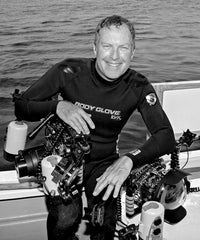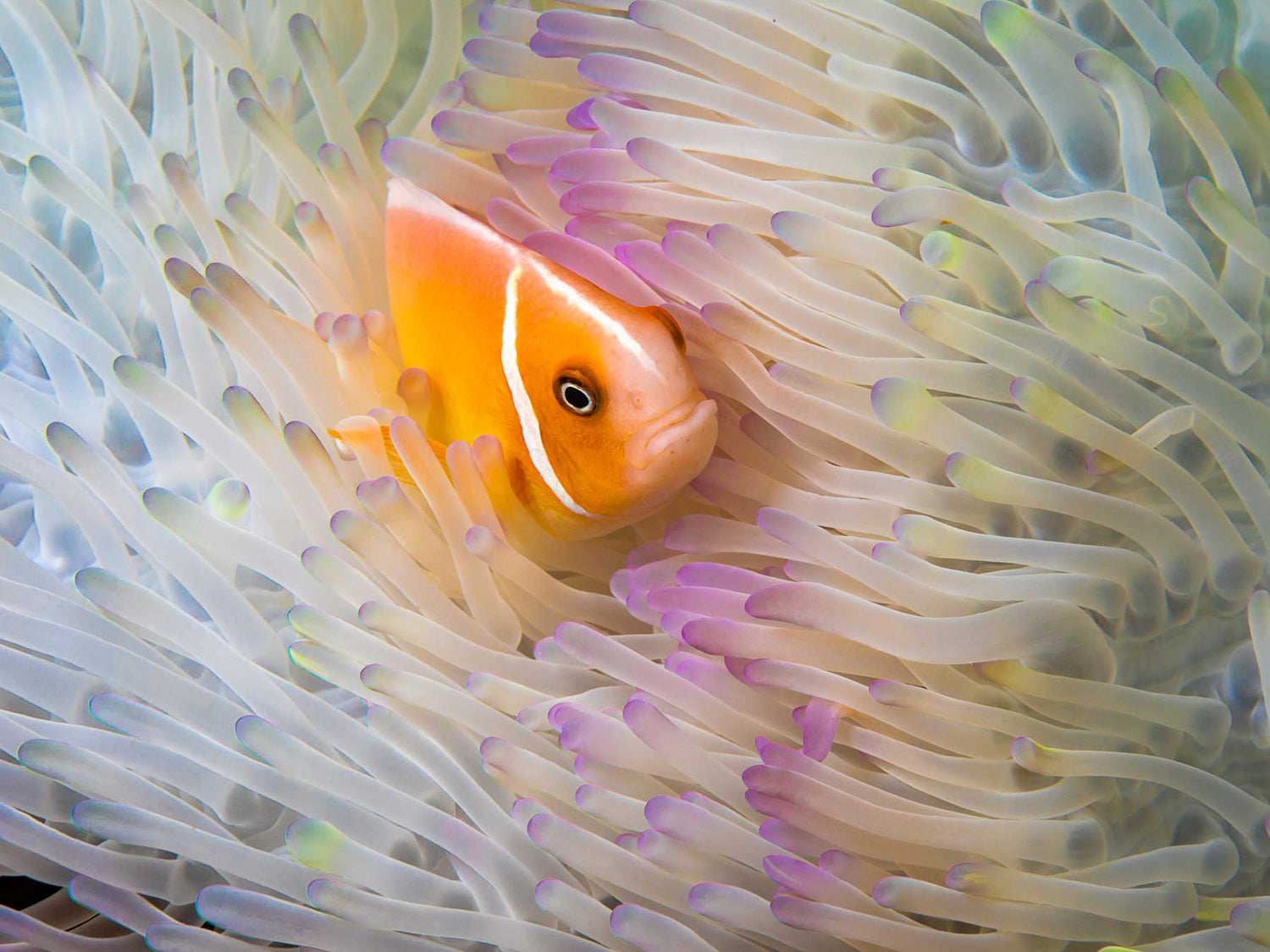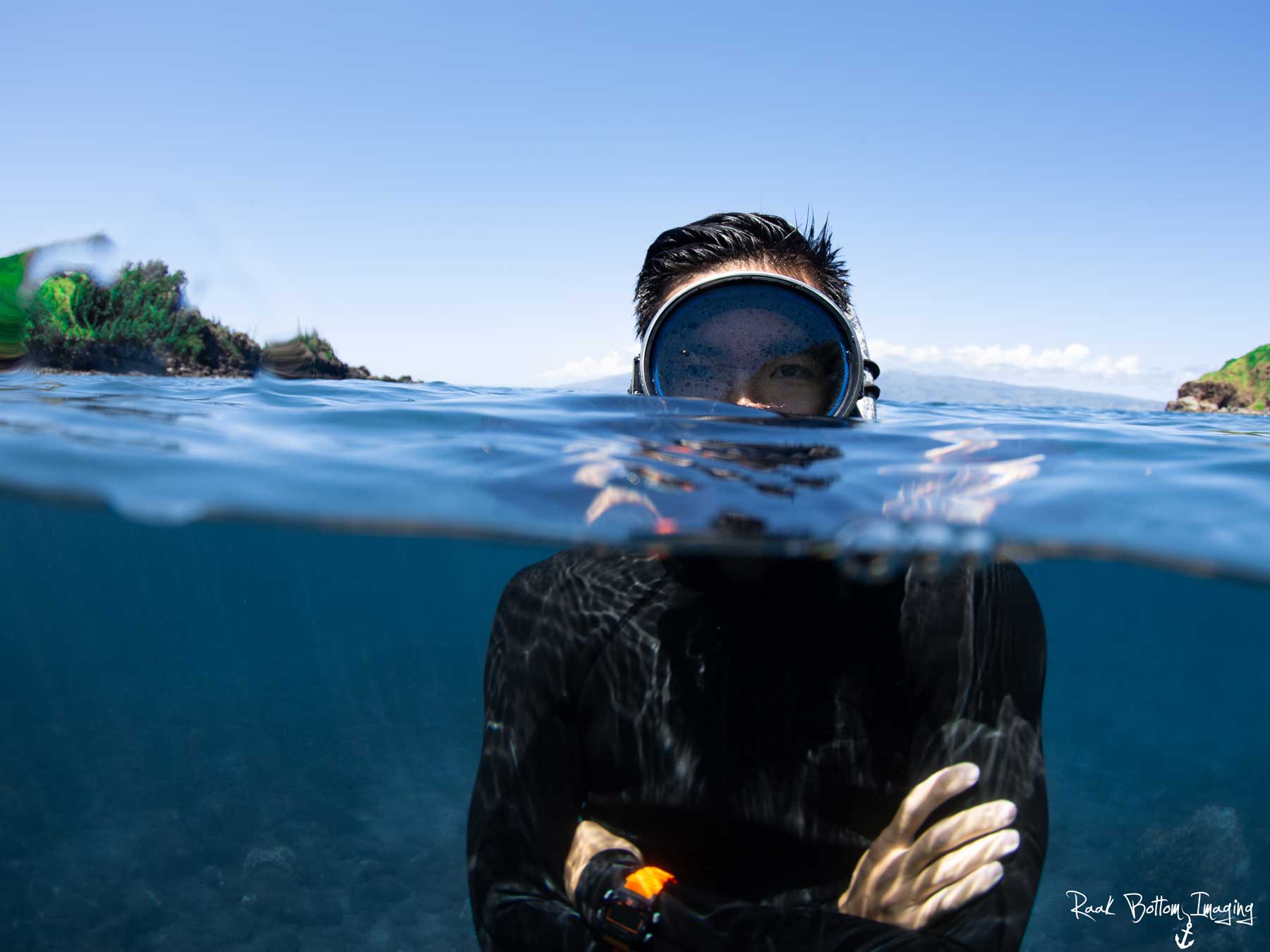By David Fleetham
The water in Yap was a balmy 84 degrees. This was good. I had been laying on the rubble bottom for over ten minutes waiting for the shrimp to emerge from its den beside the goby that had been warily watching me the entire time. My elbows were on the bottom to hold a Canon 5D Mark IV in my Ikelite 200DL housing steady and my eye was trained on the 45º viewfinder while attempting the most relaxed breathing I could muster so as to not disturb my vigilant subject. The dive site is named “Slow and Easy”. It is ten minutes away from the Manta Ray Bay Resort where I was spending three weeks with groups of divers that had one thing in mind…..take pictures underwater or more accurately take better pictures on their last day than they were taking on their first day.

The red-banded prawn-goby, Amblyeleotris fasciata, is common in patches of coarse carbonate or volcanic sand of outer lagoon and seaward reefs. Occurs in pairs and burrow with a yellow species of prawn. Copyright © David Fleetham
The goby finally moved to one side and reluctantly allowed the shrimp, claws and arms filled with tiny bits of rubble, to emerge from the den it had constructed for the two of them. The shrimp kept one antennae always in contact with the goby. They communicated through this umbilical cord. Once at the maximum distance this would allow, the shrimp dumped its load and disappeared back into the hole for further excavation. I had managed eleven shots in the few seconds it took to complete the operation with my twin Ikelite 161 strobes firing on each shutter release. The bright flashes of light had no apparent effect on my subjects and I backed away slowly and waved to a nearby photographer in search of a subject to share the opportunity.

An aerial view of the southern end of the reef surrounding the island of Yap, Micronesia. One dive boat is anchored at Yap Cavern’s, a famous site for scuba divers. Copyright © David Fleetham
Yap is part of the Federated States of Micronesia and the Yapese people's indigenous cultures and traditions are admirably resolute compared to other states in the FSM, which include, Chuuk, Pohnpei and Kosrae. The main island of Yap is actually four islands of which three are connected and there are fourteen outer islands (mostly atolls) scattered to the east and south of the main islands, some nearly 500 miles away. The entire state has come to be known as Yap in recent years. Colonia is the capital and the surrounding land is mostly made up of rolling hills that lead down to mangrove forests along the coast interspersed with narrow beaches.
Temperatures range from 75-86ºF (23-30ºC) through out the year with heavy rains possible at any time. The water temperature is a balmy 82-84ºF (27-28ºC) with a 3mm wetsuit being more than enough to be comfortable on some of the longer dives. There are limited flights into Yap and no mater where you are coming from your best bet is to have the resort suggest possible routes which they are happy to even book for you. Most itineraries include a stop in Guam and then a flight on United Airlines to Yap.

This unique image shows a manta ray, Manta alfredi, with one cephalic fin curled and the other extended in M'il Channel, Yap, Micronesia. Copyright © David Fleetham
Yap and the Manta Ray Bay Resort was one of the first locations to be celebrated as the best place in the world to observe manta rays up close at cleaning stations and witness mating “trains” of mantas gliding one after the other through two of the channels in the outer reef that surrounds the islands. Over 50 manta rays have been identified and named through underside photographs of the unique patterns that they retain for life. If you are fortunate enough to capture an image of a new individual you then get the honor of naming it.
Dives in these channels are timed with the tides to obtain the best visibility with incoming clear open ocean water. The guides know these areas like the path to their village and will put you in just the right place to have these winged giants swoop over your head. At the cleaning stations small wrasse and butterflyfish search the mantas for parasites on their extensive surface and even in the gills and mouth. Yap State is a field research site for Manta Trust (www.mantatrust.org) a UK-based charity that co-ordinates global research and conservation efforts for manta rays, their close relatives and their habitat. The rays are being identified, measured and indexed in a custom database for the conservation of all Micronesian manta rays.

An aerial view of the Manta Ray Bay Resort in the town of Colonia. Copyright © David Fleetham
The diving from the resort is done from a variety of fast boats 21 to 38 feet long, all with twin engines and hard covers from the tropical sun rays. These flat roofs proved to be a perfect take-off and landing point for my drone. The number of divers going to the different areas dictates which size vessel you end up on. Some of the routes are tide dependent and require the smaller boats to weave their way through narrow passages in the mangroves. A truly memorable experience.

The dorsal fins of blacktip reef sharks, Carcharhinus melanopterus, break the surface. Below, gray reef sharks, Carcharhinus amblyrhynchos, can be seen. Copyright © David Fleetham
There are over 30 named dive sites on the outer reef drop off. One of my favorites is Vertigo, Manta Ray Bay’s shark dive. They have been feeding sharks here for over 25 years now and the residents know the operation quite well. The moment the guide ties up to the mooring, blacktip reef sharks appear, casually swimming around the boat. They are joined by whitetip reef sharks and a bit deeper gray reef sharks. The bait is kept in a tube and placed in the reef where the sharks have difficulty getting to it.
It is the perfect set-up for photographers. The sharks know that eventually they will get a bite to eat and while patiently waiting, swim calmly amongst the divers. If you want to get a close look at a shark, just move closer to the bait container. If you prefer to view from a distance, just move back. The visibility on the outer walls is well over 100 feet and the show can last for the entire dive. It is a perfect lesson in how sharks are so misunderstood and not the senseless killing machines that so much of our world still believes. They fulfill a much needed place in the big picture of our oceans and have no interest in bubble blowing scuba divers. In most places when sharks hear divers bubbles they swim in the opposite direction, making encounters like this genuinely special.

A split view of a newly hatched baby green sea turtle, Chelonia mydas, an endangered species, just entering the ocean off the island of Yap, Micronesia. Copyright © David Fleetham
The outer reef stretches furthest from the island to the south. Here you find Yap Caverns, definitely one of the countries top five dive sites. Spinner dolphin are regularly encountered on the commute and if they are in the mood will come to the bow and stay with the boat for much of the trip. Strong currents regularly sweep down the wall in varying directions and meet not too far from the site in a swirling soup of deep water nutrients where you regularly can see a complete food chain competing for a meal. Tuna chase small baitfish to the surface where they are attacked from above by sea birds.

The longnose filefish, Oxymonacanthus longirostris, reaches nearly four inches in length. Copyright © David Fleetham
The caverns themselves are a section of the wall that collapsed into the deep and provides a sanctuary from the moving water. The caves, canyons and swim throughs provide a maze that takes more than just one dive to explore. On the outer wall, closer to the current, colorful schools of anthias pulse above the reef plucking passing morsels. Clownfish in various colors dart about their anemones attending to the nest of eggs they have placed just beside their tentacled host. Deeper down gray reef sharks regularly visit a cleaning station. These sharks must always swim and when being cleaned will hover vertically with their tails beating just enough to keep them in one position while small wrasse enter their mouth to check between their teeth. This is always a two tank trip with lunch, sometimes even three tanks depending on the conditions and the enthusiasm of your fellow passengers.

This common anemonefish, Amphiprion perideraion, is most often found associated with the anemone, Heteractis magnifica, as pictured here. This particular anemone has closed and its guests are tucking in where ever possible. Copyright © David Fleetham
No mater how good the dives were it is always a pleasure to step off the boat back at the resort. Showers and a swimming pool wait for you there to remove every last bit of salt. Divers hang their gear to dry over night and have individual lockers to place everything. Adjacent to this area are camera bays set up for photographers so you don’t have to drag your equipment back to your room each night. Every section has its own lockable storage compartment and charging station.
Right off the dive shop a short walkway over the water leads to the Mnuw, a 170 foot long Phinisi schooner originally from Indonesia that is the resorts restaurant and bar. The ship was constructed from massive beams with teak walls that are now well over 100 years old. It has three levels with two bars and a huge movie screen mounted in the forward rigging where marine life presentations take place along with first run movies. I recommend the fresh fish tacos and a Hammerhead Amber ale made from the resorts own micro brewery, The Stone Money Brewing Company. Freddy, their Swiss brew meister produces two varieties in 600 liter batches just off the hotels lobby and has this down to a fine science.

This young woman (MR) is in a traditional outfit for cultural ceremonies and is weaving a basket between two large pieces of stone money on the island of Yap, Micronesia. Copyright © David Fleetham
The Stone Money name comes from one of the islands most intriguing cultural customs. The ancient currency still in practice today involves round carved stones known as “Rai” that are up to four meters in diameter with a hole in the center. The rock for the money does not exist anywhere on Yap. These massive solid stone wheels were quarried from as far away as Papua New Guinea, although the majority of them were cut by hand in the nearby islands of Palau. Still a long trip by outrigger canoe. Palau is over 300 miles away. There are over 6000 stones of varying sizes around the islands and the value of each is tied to not just the size but also the fable of the pilgrimage to get the Rai back home. Over the years canoes and lives were lost. The “coins” are, unquestionably, the largest currency that exists. There is not even a close second. Interestingly, when a stone is used in a land transaction or wedding, it is often not moved. It just becomes common knowledge who the new owner is.

A kayak tour through a mangrove forest. Copyright © David Fleetham
Six minutes from the resorts dock is a site reserved for night dives called Rainbow Reef. Visibility inside the lagoon is not the 100 foot + that you find outside during the day, but this site holds a very unique encounter. Impossibly colored mandarinfish inhabit the maze of antler coral found here and shortly after dusk males search for a mate. After a complicated dance that can include competing males, a pair will rise out of the coral and in an explosion of eggs and sperm renew their species. This happens in several locations around the world, but this site is unique in the density of the population. Once you find a couple and follow them for a while you will inevitably pass by several others and often lose your original pair in the bedlam.

This image was captured a mile off the island of Yap at night with the bottom 1000+ feet below. Hundreds of these squid passed by very quickly. This one paused just briefly for a portrait. It appears to be a Japanese common squid also known as a Japanese flying squid, Todarodes pacificus, one of the most abundant of the commercially valuable squid in the world. Copyright © David Fleetham
On nights when the ocean is calm blackwater diving can reveal creatures that you’ll never see anywhere else. Yap is on the rim of the Marianas Trench and just 100 miles from the Challenger Deep site, the deepest point on our planet. A mile or more out into open ocean a buoy is set out with a light at the surface and another 60 feet down on a line to attract larval creatures that make a migration to the surface each night. A dive guide keeps the buoy and group together while spotting subjects.
This is not a dive for a novice and it does take a few minutes to orient yourself to the whole situation. On my last blackwater dive hundreds of squid, from 6 inches in length to two feet long darted past us in waves. Occasionally one would stop momentarily to be photographed and then bolt back to the mob. When we got back on the boat everyone realized they were covered in tiny octopus that were dropping off our gear and squirming about on the deck. It took fifteen minutes searching with lights to find them all and return them to the inky sea. Looking back at the island we were surprised to see the lights of the town way to the north. We had travelled nearly two miles in a current we could not even feel because everything is moving with you.

A motion blurred image of a group of Yapese dancers in traditional outfits for cultural ceremonies. Copyright © David Fleetham
The flight out of Yap is in the evening and often on this last day you will have the option of touring one of the local villages. On occasion some of the young people will present several dances in their traditional colorful dress. They are enthusiastic performers and always curious about visitors. There is time for one last sunset and meal aboard the Mnuw before the final packing of bags. Off the beaten path, Yap is one of those destinations that will lure you back. I have lost count of the number of times I have visited over the last thirty years.

The Circus Wreck sits in a channel off the island of Yap in Micronesia. This diver (MR) is pictured exploring the propeller. Copyright © David Fleetham
Manta Fest 2020
David Fleetham will be one of six photo pros who will be participating in the 14th annual Manifest photo festival from August 30 through September 12th. Manta Ray Bay Resort packages are available from 4 nights to 14 nights and with only 30 rooms this event is limited to just 60 divers. In addition to seminars, workshops and evening media presentations, all participants will be eligible for a photo contest involving images shot during the festival. There are separate categories for digital SLR, compact camera and video, so both the seasoned shooter and beginner have a chance at some impressive prizes from Ikelite, Mares, Light and Motion, Henderson wetsuits and several dive vacation packages including a 10 day luxury live aboard trip to Indonesia for the Best in Show category. The pros will be diving every day with the participants and offering tips above and below to improve your photo skills. For more information and to book a spot check out www.mantafest.com.
 Ambassador David Fleetham left his hometown of Vancouver, Canada, for Maui in 1986 and never looked back. He earned his USCG Captain's license while working in various dive charter businesses, shooting, and submitting his photos to magazines and businesses. One of the most prolific underwater photographers of his time, David now has galleries and agents in over 50 countries that reproduce his images thousands of times each year. Follow his work on Instagram @davidfleetham
Ambassador David Fleetham left his hometown of Vancouver, Canada, for Maui in 1986 and never looked back. He earned his USCG Captain's license while working in various dive charter businesses, shooting, and submitting his photos to magazines and businesses. One of the most prolific underwater photographers of his time, David now has galleries and agents in over 50 countries that reproduce his images thousands of times each year. Follow his work on Instagram @davidfleetham
Additional Reading
Photographing Giant Mantas in Yap
Techniques for Photographing Sharks
Planning a Trip to Tonga to Swim with Humpback Whales
An Insiders Guide to Diving Wakatobi Resort Indonesia
Shooting Manta Rays at Night Without a Strobe













![Under Pressure | The Art of Underwater Filming with Matt Jacobs [VIDEO]](http://www.ikelite.com/cdn/shop/articles/matt-jacobs-under-pressure.jpg?v=1645885213&width=1440)